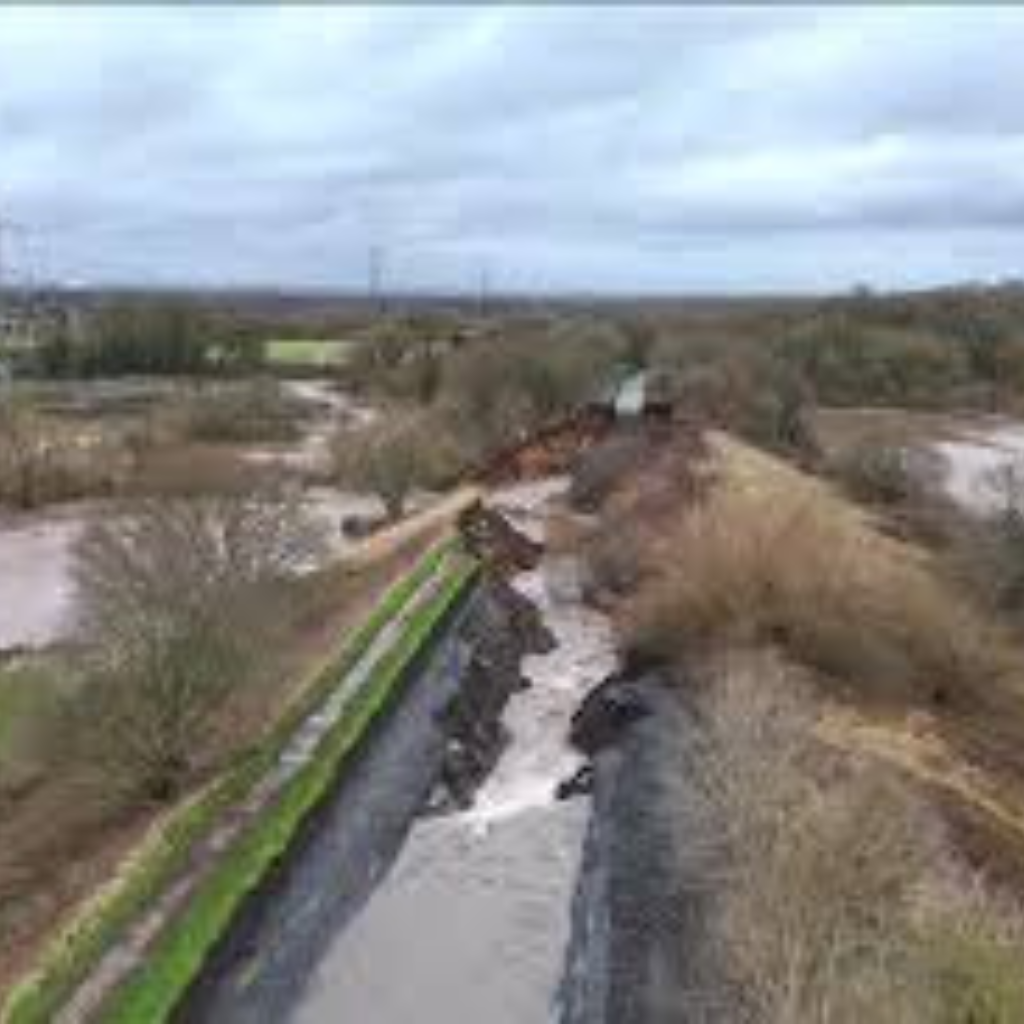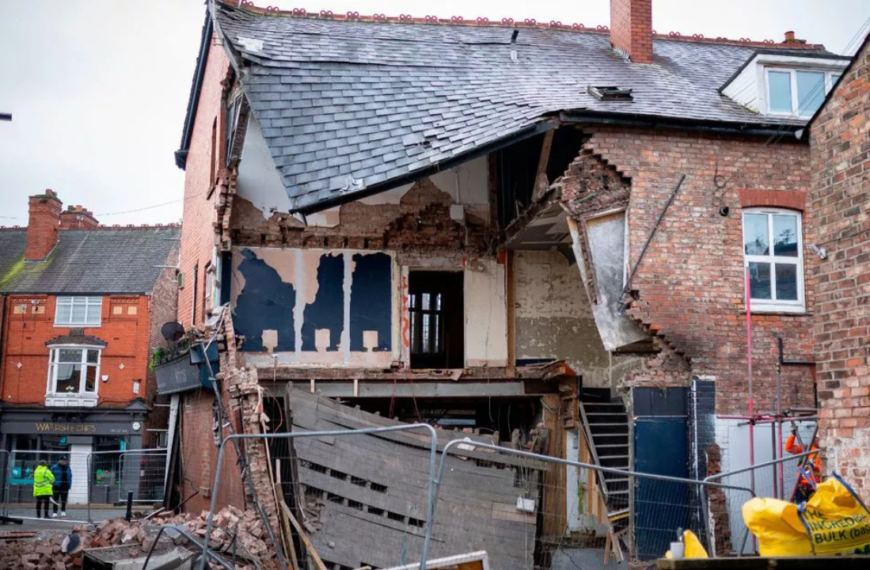The Bridgewater Canal, often regarded as one of the most significant landmarks of British industrial history, has long stood as a testament to innovation and resilience. Opened in 1761, it was the first canal in England built without following an existing watercourse, revolutionizing the transportation of goods during the Industrial Revolution. Stretching across 39 miles, it connected Manchester, Runcorn, and Leigh, cementing its importance in shaping the region’s economic and social landscape.
For over two centuries, the canal has been more than just a waterway; it has been a cherished part of local life, offering picturesque walking routes, boating opportunities, and a link to the area’s rich history. However, this enduring symbol of engineering strength faced a dramatic setback on January 1, 2025, when a catastrophic breach occurred in Dunham Massey. This marked the first significant collapse of the embankment in over 50 years, shaking the local community and sparking urgent concerns about infrastructure resilience.
The breach, triggered by relentless rainfall that saturated the embankment, led to the complete collapse of a section of the canal. Water spilled into the adjacent fields, leaving a gaping void in the embankment and disrupting life in the surrounding areas. This event not only highlighted the challenges posed by extreme weather but also underscored the need to safeguard historical infrastructure for future generations.
The Incident: What Happened?
The breach at Dunham Massey was triggered by unrelenting rainfall that began on Tuesday afternoon and continued into the night. The intense deluge saturated the embankment to the point of failure, causing a large section of the canal to give way. The breach diverted vast amounts of water into neighboring fields, leaving behind a dramatic void in the embankment and a significantly lowered water level in parts of the canal.
Drone footage captured by Altrincham Today and on-the-ground videos shared by local residents reveal the extent of the damage. One side of the canal has entirely collapsed, with water gushing through the breach. Eyewitnesses described the scene as “astonishing,” as the normally tranquil canal turned into a torrent, flooding adjacent land and disrupting the surrounding area.
Historical Context: Breaches of the Bridgewater Canal
The Bridgewater Canal has withstood the test of time, playing a vital role in the region since its construction. However, this is not the first breach in its history. Shortly after its opening in the 18th century, the canal experienced its first structural failure. More recently, in 1971, the Bollin aqueduct fractured, spilling canal water into the River Bollin and causing extensive flooding. That breach necessitated a two-year closure and repairs costing £250,000—equivalent to over £3 million today.
In 2005, a sluice failure caused localized flooding, but the scale of damage was far less significant. The current breach at Dunham Massey is unparalleled in magnitude since the Bollin aqueduct incident, underscoring the challenges of maintaining aging infrastructure in the face of modern environmental pressures.
Immediate Impact of the Breach
The collapse has already had profound effects on the local community. Fields adjacent to the canal are inundated with water, and the canal’s levels have dropped by about a foot in nearby Lymm, as reported by local observers. Roads near the site are impassable, and police have cordoned off the area, closing a popular walking route for safety reasons.
Efforts to control the water flow are underway. Emergency wooden slats were installed at Agden to stem the outflow, but residents like Ian Daniels reported that substantial amounts of water are still bypassing these barriers, creating a noticeable current through the canal.
Community and Social Media Reactions
The breach has sparked widespread discussion and concern among locals, with social media becoming a hub for updates and shared experiences. Ian Daniels noted the significant drop in water levels and the strong flow in the canal, while Ian Harwood reminisced about the 1971 breach, comparing its cause and scale to the current event.
Dramatic drone footage shared by Altrincham Today and videos from residents like Peter White have garnered significant attention, highlighting the shocking scale of the collapse. The community’s reaction reflects a mix of amazement at the event’s rarity and apprehension about the long-term impact.
Economic and Environmental Consequences
Repairing the breach is expected to be a costly and time-consuming process. Given that the 1971 Bollin aqueduct repair cost the equivalent of £3 million today, the Dunham Massey breach could demand similar or even greater resources. The timeline for repair and reopening remains uncertain, potentially affecting the canal’s recreational and logistical use for months or years.
Environmentally, the breach has caused flooding of agricultural fields, disrupting local wildlife habitats. Prolonged saturation could lead to soil degradation and further ecological consequences. The event also highlights the broader vulnerabilities of historical infrastructure in coping with extreme weather events.
The Role of The Bridgewater Canal Company Ltd
As the canal’s owner and custodian, The Bridgewater Canal Company Ltd, part of the Peel Land and Property Group, bears responsibility for its maintenance and repair. The company has yet to release a detailed statement on the breach but is expected to lead the recovery and repair efforts. This incident raises questions about the adequacy of current maintenance protocols and the investment required to future-proof the canal.
Future Precautions and Preventative Measures
Preventing similar incidents in the future will require a thorough assessment of the canal’s infrastructure. Modern engineering techniques and materials may need to be integrated to reinforce vulnerable sections, especially embankments susceptible to saturation. Regular inspections and maintenance programs should be enhanced to address the challenges posed by increasingly severe weather patterns.
Community involvement and governmental support will also be crucial. Funding for such projects may need to come from a combination of private investment and public grants, ensuring the preservation of this vital historical asset.
Conclusion
The breach at Dunham Massey is a stark reminder of the delicate balance between preserving historical infrastructure and adapting to modern challenges. The Bridgewater Canal, a symbol of innovation and resilience, now faces a critical test. As repair efforts commence, the event serves as an urgent call to action to safeguard such landmarks for future generations while addressing the evolving threats posed by climate change.


















